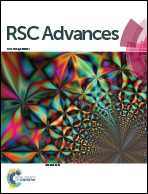Molecular engineering of the hole-transporting material spiro-OMeTAD via manipulation of alkyl groups†
Abstract
Aliphatic substituent effects on the HOMO energy levels and the ability to transport charge and form stable molecular glasses of systematically modified spiro-OMeTAD analogues were investigated. It was determined that the thermal properties, energy levels and hole mobility values are dependent on the number of alkyl substituents and their position in the investigated spirobifluorene-based hole transporting materials (HTMs). The charge mobility of HTM3 possessing a seemingly insignificant m-methyl group in the diphenylamino moieties is the highest with a value of 2.8 × 10−3 cm2 V−1 s−1 at 6.4 × 105 V cm−1 field strength. It was found that moving one methoxy group into the m-position in the diphenylamino fragment ensured a stable amorphous phase of HTM1. Moreover, the long-term stability of a solid state dye-sensitized solar cell (ssDSSC) device comprising HTM1 was significantly enhanced over a cell with spiro-OMeTAD, in lifetime tests. The findings described in this publication could be applicable to hybrid solar cell research as a number of well-performing architectures rely heavily upon doped spiro-OMeTAD as a HTM.


 Please wait while we load your content...
Please wait while we load your content...